Mount Qingcheng is located in the southwest of Dujiangyan City, Chengdu, Sichuan Province. It is one of the birthplaces of Taoism in China and a national 5A-level scenic area. Covering a total area of approximately 200 square kilometers, its main peak, Laojun Pavilion, stands at an altitude of 1,260 meters. Renowned for its natural landscape of "unparalleled tranquility" and profound Taoist culture, it is collectively known as the "Four Wonders of Sichuan" along with the peril of Jianmen Pass, the elegance of Mount Emei, and the grandeur of Kuimen. The mountain has a vegetation coverage rate of over 98%, with the highest concentration of negative ions reaching 25,000 per cubic centimeter, making it a natural oxygen bar. There are more than 10 Taoist temples in the scenic area, among which Tianshi Cave and Shangqing Palace are national key cultural relic protection units. Most of the buildings adopt the style of western Sichuan dwellings from the Qing Dynasty, following the contour of the mountain and exuding an ancient and elegant charm.
History and Culture
Taoist culture on Mount Qingcheng originated in the Eastern Han Dynasty, with a history of over 1,800 years. In 143 AD, Zhang Daoling built a thatched hut here to spread his teachings and founded the Five Pecks of Rice Taoism, establishing Mount Qingcheng as the "Fifth Heavenly Grotto" of Taoism. During the Tang and Song dynasties, Taoism flourished, and the number of temples reached more than 70; most of the existing buildings were rebuilt during the Ming and Qing dynasties. Emperor Xuanzong of the Tang Dynasty once named it "Zhangren Temple," Emperor Qinzong of the Song Dynasty granted it the plaque "Huiqing Jianfu Palace," and Zhang Sanfeng of the Ming Dynasty practiced asceticism here, leaving behind "Zhang Sanfeng's Relics."
Beyond Taoist culture, Mount Qingcheng was also an important site for ancient Chinese education. Disciples of the renowned Tang Dynasty monk Jianzhen built Yuanming Palace here, and Zhang Shi, a great Confucian scholar of the Song Dynasty, once gave lectures here. In addition, Qingcheng martial arts is an important school of Chinese martial arts. Formed in the Tang and Song dynasties and thriving in the Ming and Qing dynasties, it is famous for its "lightness, agility, flexibility, and sudden rises and falls," and is known as one of the three major martial arts systems along with Shaolin and Wudang.
Major Scenic Spots
Shangqing Palace
Shangqing Palace was first built in the Jin Dynasty, and the existing buildings were reconstructed in the Qing Dynasty. Located at the top of Mount Qingcheng, it sits at an altitude of 1,600 meters. In front of the palace, there are stone tablets inscribed with "The Fifth Famous Mountain Under Heaven" and "The First Peak of Qingcheng." The palace enshrines statues of Taishang Laojun (the Supreme Old Lord) and the Jade Emperor, among others. The stone statues of the Three Emperors from the Tang Dynasty in the Sanqing Hall are precious cultural relics. Behind the palace stand the Sacred Lamp Pavilion and the Echo Pavilion; climbing to the top offers a panoramic view of the Chengdu Plain.
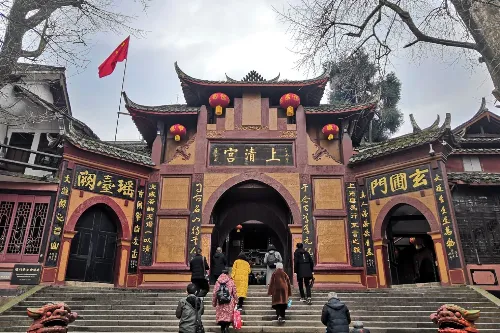
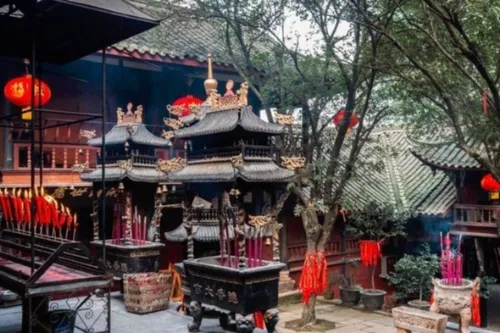
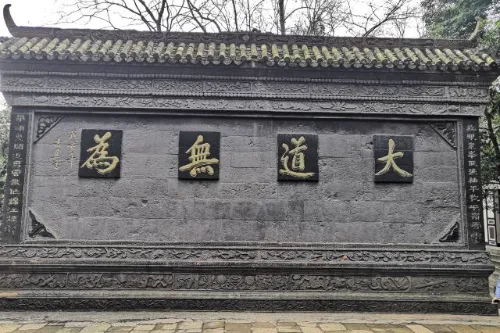
Tianshi Cave (Taoist Temple)
Tianshi Cave is the core scenic spot of Mount Qingcheng. First built in the Sui Dynasty, it gets its name from Zhang Daoling, who practiced asceticism here. The Taoist temple enshrines a statue of Zhang Daoling, and outside the temple, there are attractions such as Sandao Stone, Xixin Pool, and an ancient ginkgo tree. The ancient ginkgo tree is approximately 50 meters tall and over 1,800 years old; planted by Zhang Daoling himself, it is one of the oldest ginkgo trees in China. The Tianshi Cave complex covers an area of 7,000 square meters, and the existing halls, rebuilt in the Qing Dynasty, are built against the mountain, presenting a magnificent spectacle.
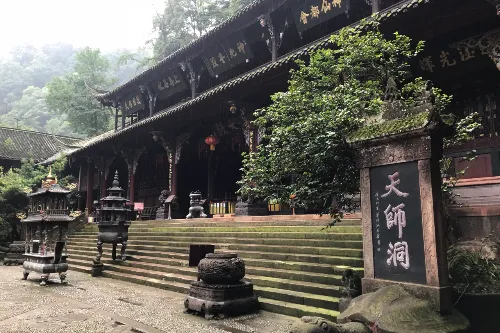
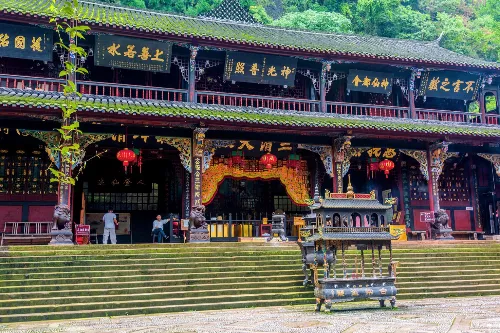
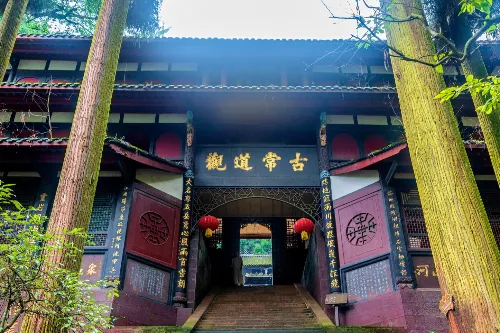
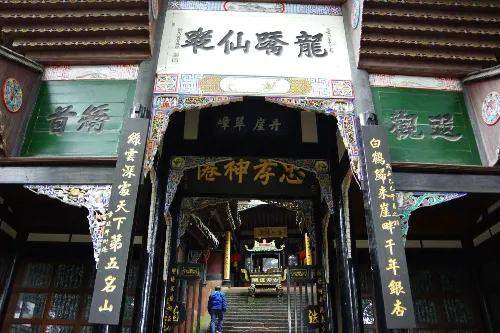
Jianfu Palace
Jianfu Palace was first built in the Tang Dynasty, and the existing buildings were renovated in the Qing Dynasty. Located at the entrance of Mount Qingcheng, it is the first palace encountered when entering the mountain. Its name is derived from the plaque "Huiqing Jianfu Palace" granted by Emperor Huizong of the Song Dynasty. The palace enshrines statues of the Five Mountain Emperors and the Queen Mother of the West, among others. In front of the palace lies Jianfu Palace Square, where the stone tablet inscribed with "Qingcheng Under Heaven is Unparalleled in Tranquility" (written by Zhang Daqian) is a popular spot for tourists to take photos.
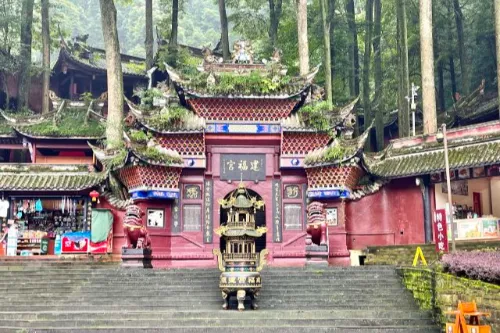

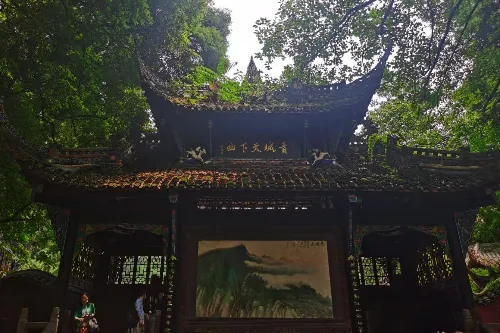
Yuecheng Lake
Yuecheng Lake is a man-made lake on Mount Qingcheng, located at the foot of Zhangren Peak at an altitude of 800 meters. With a water surface area of approximately 15,000 square meters and a depth of about 10 meters, the lake and the surrounding mountains form a delightful contrast. Tourists can take a boat (ticket price: 5 yuan) across the lake to reach the cable car station. There is a restaurant by the lake serving Qingcheng-style specialty dishes.
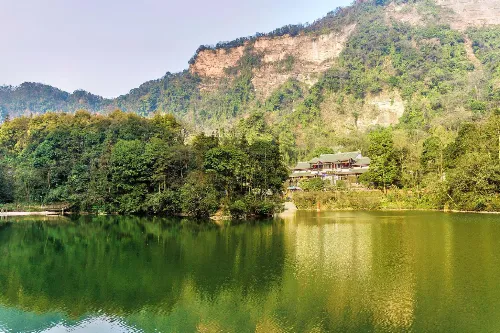
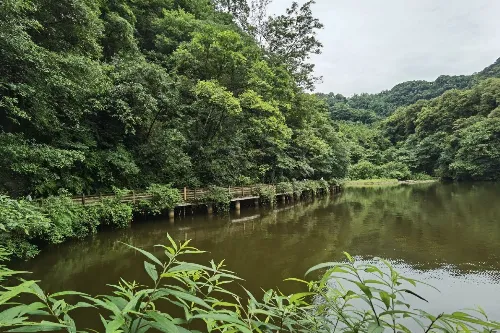
Laojun Pavilion
Perched atop Laoxiao Peak, the highest peak of Mount Qingcheng, at an altitude of approximately 1,260 meters, Laojun Pavilion is one of the iconic buildings representing the Taoist culture of Mount Qingcheng and an excellent spot to overlook the entire mountain scenery.
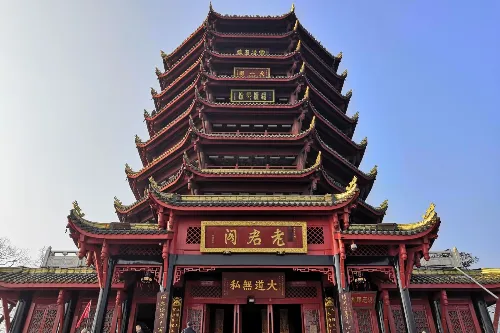
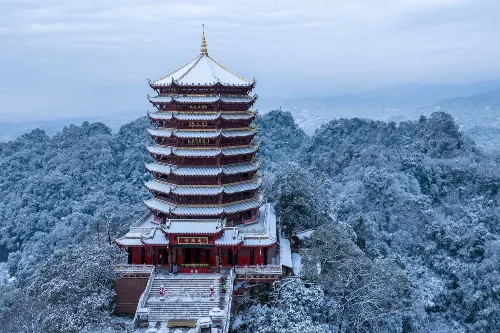
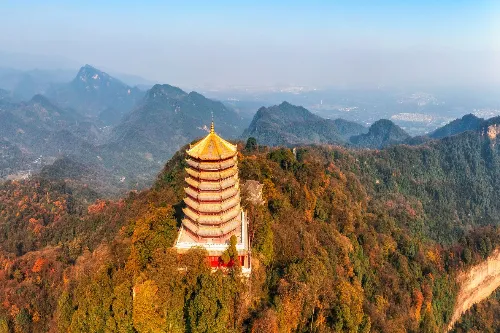
Chaoyang Cave
Located on the southern hillside of Laoxiao Peak, the main peak of Mount Qingcheng, Chaoyang Cave gets its name from its eastern-facing entrance, which is the first to receive sunlight at dawn. It is a highly representative natural karst cave and Taoist cultural heritage site on Mount Qingcheng.
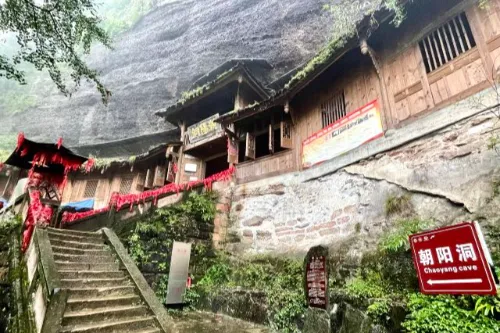
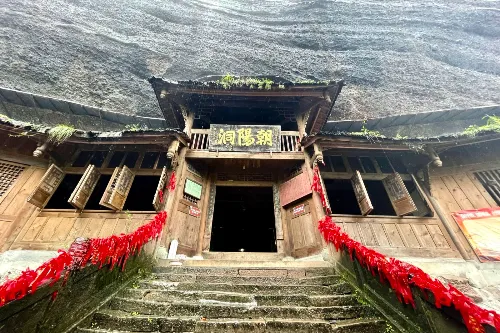
Yuqing Palace
As one of the important Taoist temples on Mount Qingcheng, Yuqing Palace is situated at the foot of Zhangren Peak on the Front Mountain of Qingcheng, at an altitude of approximately 1,000 meters. Backed by lush green peaks and facing a deep valley, it derives its name from the fact that it once enshrined a statue of Yuqing Zhenwang (a Taoist deity). Its history dates back to the Tang Dynasty, and after renovations during the Ming and Qing dynasties, most of the existing buildings were reconstructed in modern times following traditional styles, fully embodying the integrated characteristics of "tranquility" and "Taoism" of Mount Qingcheng.
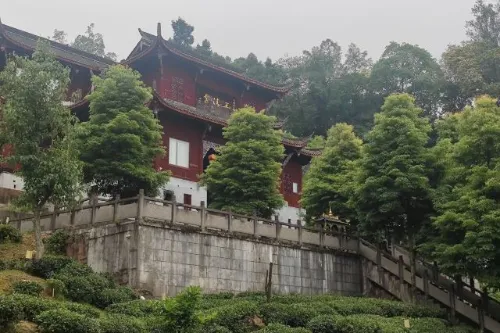
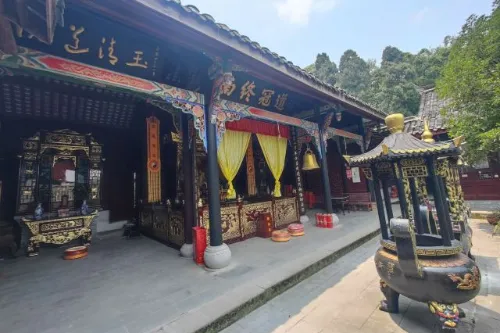
Recommended Tour Routes
One-Day Tour Route: Jianfu Palace (30 minutes) → Yuecheng Lake (10 minutes by boat) → Front Mountain Cable Car (15 minutes uphill) → Shangqing Palace (1 hour) → Laojun Pavilion (40 minutes) → Tianshi Cave (1.5 hours) → Chaoyang Cave (30 minutes) → Front Mountain Cable Car (15 minutes downhill) → Yuecheng Lake (10 minutes by boat) → Jianfu Palace (return). This route covers core scenic spots and requires taking cable cars and boats, making it suitable for tourists with limited time.
Two-Day Tour Route: D1: Jianfu Palace → Natural Gallery → Tianshi Cave → Zushi Hall → Shangqing Palace (stay overnight at Shangqing Palace); D2: Shangqing Palace → Laojun Pavilion → Yuanming Palace → Yuqing Palace → Yuecheng Lake → Jianfu Palace. This route allows in-depth experience of Taoist culture, with approximately 6 hours of hiking, suitable for tourists with good physical fitness.
Travel Tips
- It is recommended to carry a lightweight backpack and wear non-slip shoes. The stone steps on the Front Mountain are relatively steep, and some sections require using both hands and feet; hiking poles can be rented (10 yuan per pole).
- The vegetarian restaurant at Shangqing Palace serves Taoist vegetarian meals at 25 yuan per person, with dishes including "vegetarian ginkgo stewed chicken" and Qingcheng pickles. Dining hours are from 11:30 to 13:30.
- In summer, the temperature in the mountains is 5-8℃ lower than in urban areas, so a thin jacket is necessary; in winter, some road sections are icy and snowy, so waterproof shoes are recommended, and crampons can be purchased at the scenic area entrance (15 yuan per pair).
- The one-way ride on the Front Mountain Cable Car takes 15 minutes. During peak seasons (weekends and holidays), waiting times are long, so it is advisable to arrive at the scenic area before 9:00 a.m. to avoid crowds.
- Mount Qingcheng is famous for its "tranquility" (you), so it is recommended to spend more than half a day here to quietly experience the integration of Taoist culture and natural landscapes.
Important Notes
- Smoking is prohibited in the scenic area, with a fine of 50-200 yuan for violators. Taking photos is not allowed in all Taoist temples, and visitors must observe Taoist etiquette.
- There are many insects and ants in the mountains. It is recommended to wear long pants, avoid bright-colored clothing, and do not feed wild animals arbitrarily.
- There are no supply points along the hiking route from Tianshi Cave to Zushi Hall. Prepare drinking water and dry food in advance (energy bars and chocolate are recommended).
- The last departure time of the Front Mountain Cable Car is 17:00. Arrange your downhill time reasonably to avoid hiking at night; visitors to the Back Mountain must take the cable car downhill before 16:30.
- When purchasing local specialties, it is recommended to buy from designated stores in the scenic area and avoid roadside stalls to prevent counterfeit and shoddy products.
Transportation
- High-Speed Railway: Take the intercity high-speed rail from Chengdu Xipu Railway Station to Qingchengshan Railway Station. There are more than 20 trains daily, with a travel time of 30 minutes and a ticket price of 10 yuan. Qingchengshan Railway Station is about 1.5 kilometers from the scenic area entrance; you can walk there or take a sightseeing bus (5 yuan).
- Bus: Chengdu Chadianzi Bus Station and Chengdu Xinnanmen Bus Station have direct buses to Mount Qingcheng, with more than 10 buses daily. The travel time is 1.5 hours and the ticket price is 25-30 yuan. From Dujiangyan urban area, take Bus No. 101 to Mount Qingcheng Scenic Area; buses run every 15 minutes, with a travel time of 40 minutes and a ticket price of 2 yuan.
- Scenic Area Sightseeing Bus: The sightseeing bus from Qingchengshan Railway Station to the scenic area entrance costs 5 yuan per person; the internal sightseeing bus (Front Mountain - Back Mountain) costs 20 yuan per person, and the ticket can be used for multiple rides.
- Self-Driving: Route: Chengdu → Rongchang Expressway → Dujiangyan West Exit → Qingchengshan Avenue. The total travel time is about 1.5 hours. The scenic area parking lot charges 20 yuan per day. It is recommended to arrive before 9:00 a.m. during peak seasons (weekends and holidays).
Opening Hours
Mount Qingcheng Scenic Area is open year-round. The daily opening hours are 8:00-17:30, and entry is stopped at 17:00. The operation hours of the Front Mountain Cable Car are 8:30-17:00; the operation hours of the Back Mountain Cable Car are 9:00-16:30. Major Taoist temples such as Jianfu Palace and Shangqing Palace are open from 8:00 to 18:00, and close early at 17:30 in winter.
Tickets
Peak season (March 1 - November 30): 80 yuan per person; Off-season (December 1 - February 28 of the following year): 70 yuan per person.
You can search for the official scenic area WeChat public account "青城山都江堰" to get the latest updates or buy tickets online.
Online Booking
Click here to jump to the Trip.com ticketing platform for ticket purchase.


